Florenz – Cappella Sassetti, Domenico Ghirlandaio, Anbetung der Hirten und Szenen aus dem Leben des Hl. Franz von Assisi in der Kirche Santa Trinita, 1483/86
Domenico Ghirlandaio, Adoration of the Shepherds and Scenes from the Life of St. Francis of Assisi, 1483/86

Antonio Rossellino (1427/28-1479) bzw. zuletzt Andrea del Verrocchio (1435-1488) zugeschrieben, Francesco Sassetti, um 1464, Marmor, Museo del Bargello
Die Büste von Francesco Sassetti (1421-1490), Bankier und einflussreicher Vertrauensmann der Medici, orientiert sich im Gesichtsausdruck wie im Gewand an römisch-antiken Vorbildern. Zugleich wird die Individualität und der entschiedene, hellwache Charakter einer Schlüsselfigur des florentinischen Quattrocento deutlich.
The bust of Francesco Sassetti (1421-1490), banker and influential confidant of the Medici, is based on Roman-antique models in both facial expression and costume. At the same time, the individuality and decisive, wide-awake character of a key figure of the Florentine Quattrocento becomes clear.

Francesco Sassetti erwirbt 1478 die Kapelle in Santa Trinita und schließt am 25. Dezember 1480 einen Vertrag mit Domenico Ghirlandaio (1449-1494). Die Ausführung der Altartafel und Fresken erfolgt von 1483 bis 1486. Der erfolgreichste und produktivste Maler der Stadt schafft ein großartiges, noch heute gut erhaltenes Bilderensemble, das sein Hauptwerk und eines des florentinischen Quattrocento ist. – Wegen der schwierigen Lichtverhältnisse beschränke ich mich auf die Hauptwand.
Francesco Sassetti acquired the chapel in Santa Trinita in 1478 and signed a contract with Domenico Ghirlandaio (1449-1494) on December 25, 1480. The altarpiece and frescoes were executed between 1483 and 1486. The city’s most successful and productive painter, Ghirlandaio created a magnificent ensemble of paintings that is still well preserved today and is his main work and one of the Florentine Quattrocento. – Due to the difficult lighting conditions, I will limit myself to the main wall.
Piazza Santa Trinita mit Arno-Brücke
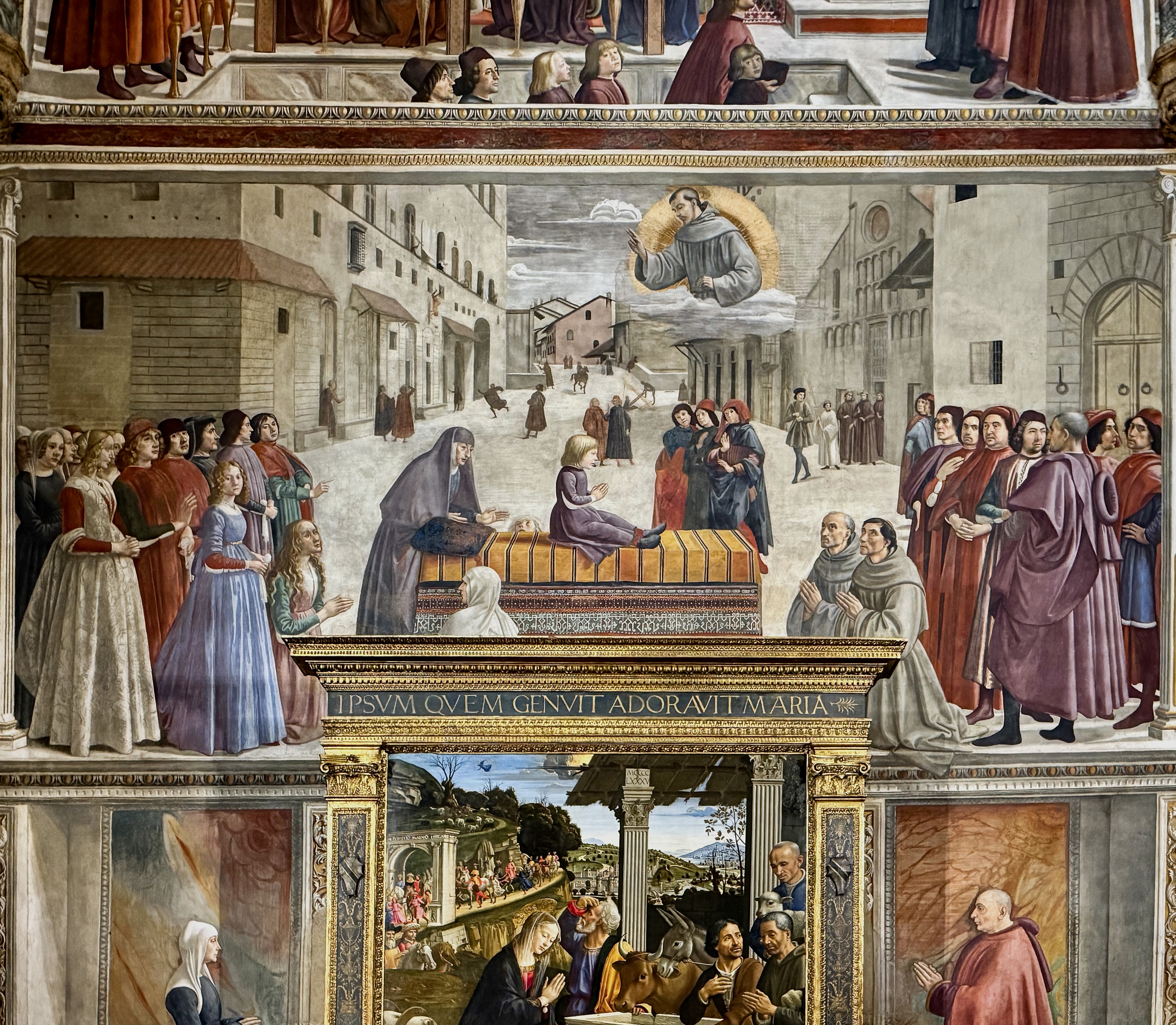
Florenz, Santa Trinita, Cappella Sassetti, Domenico Ghirlandaio, Auferweckung eines toten Kindes. Wie bei allen Fresken handelt es sich um eine Szene mit dem Hl. Franz von Assisi, dem Namenspatron des Stifters. Das posthume Wunder wird in das späte 15. Jh. verlegt. Berühmt ist die dargestellte Örtlichkeit: das damalige Aussehen des Platzes vor Santa Trinita mit dem Blick zur Brücke über den Arno. Unter den zeitgenössischen Personen sind links die Töchter Sassettis und rechts einzelne ihrer Ehemänner zu sehen.
Domenico Ghirlandaio, Raising of a Dead Child. As with all the frescoes, this is a scene with St. Francis of Assisi, the patron saint of the founder. The posthumous miracle is dated to the late 15th century. In the background you see the square in front of Santa Trinita at the time with a view of the bridge over the Arno. The contemporary figures include Sassetti’s daughters on the left and some of their husbands on the right.
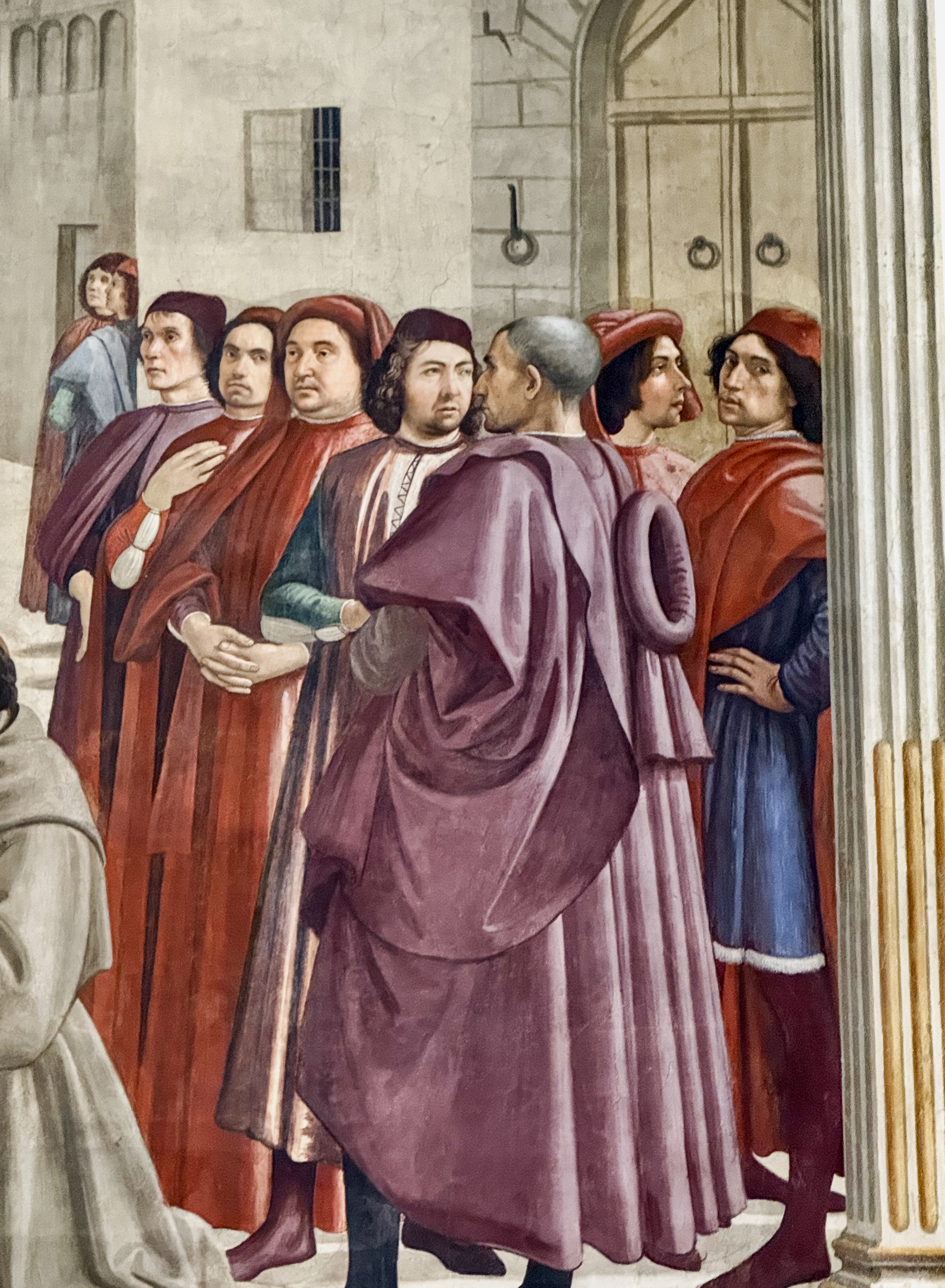
Detail des vorigen. Unter den Männern sticht vor allem die großartige Rückenfigur ins Auge. Der majestätische Faltenwurf des Mantels erinnert an Masaccio in der Cappella Brancacci. Rechts am Rand blickt Ghirlandaio selbstbewusst auf den Betrachter.
Detail of the previous one. Among the men, the magnificent back figure is particularly striking. The majestic drapery of the cloak is reminiscent of Masaccio in the Cappella Brancacci. Ghirlandaio looks confidently at the viewer on the right-hand edge.
Florenz – Cappella Sassetti: Piazza della Signoria
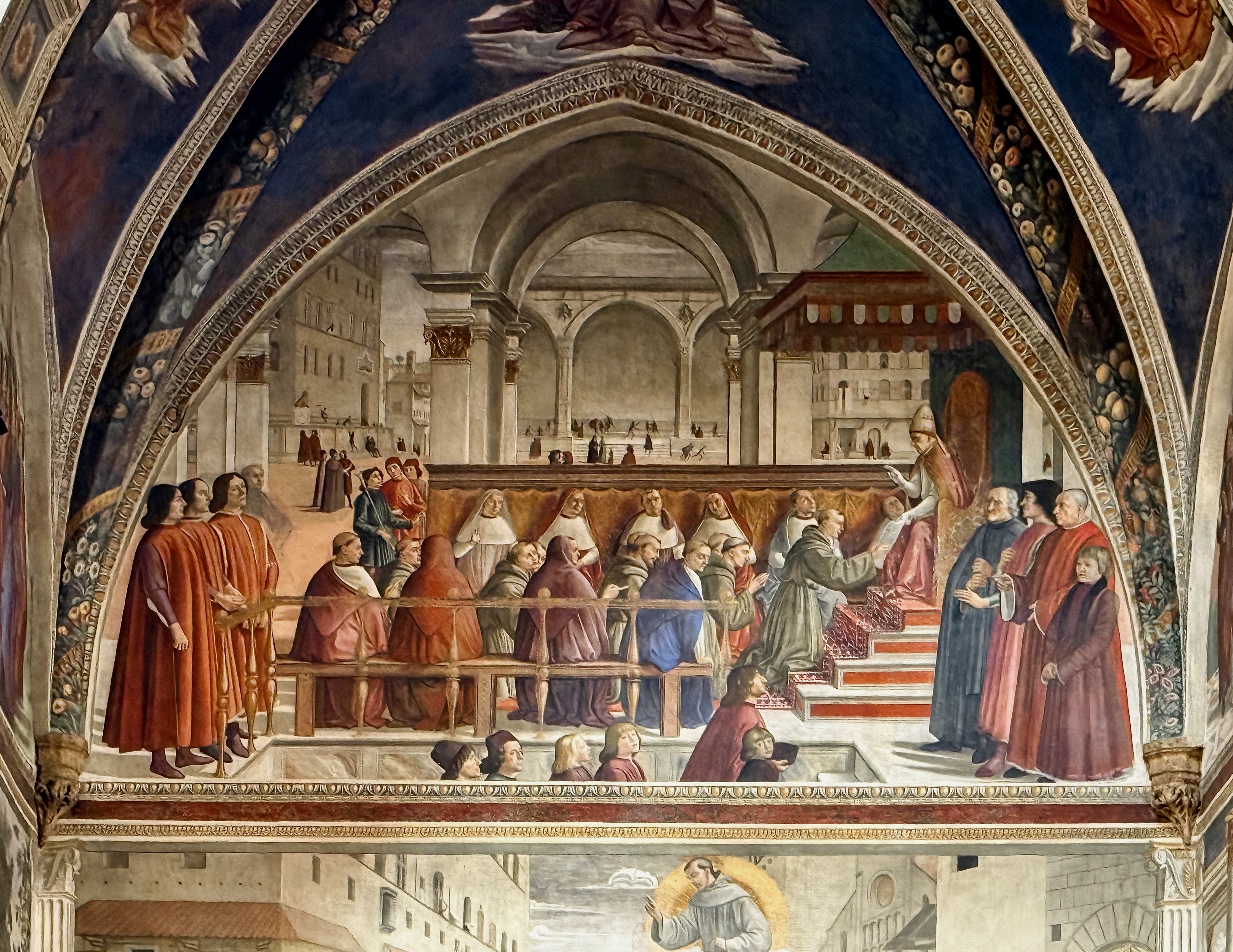
Das obere Fresko ist noch berühmter: die Bestätigung der Ordensregel der Franziskaner. Sie vollzog sich 1209 in Rom. Bei Ghirlandaio spielt sie jedoch in Florenz. Im Hintergrund sieht man die Piazza della Signoria, den Palazzo Vecchio und die Loggia dei Lanzi. Rechts am Rand stehen Francesco Sassetti und sein Sohn Federico. Neben ihm mit schwarzem Haar Lorenzo de‘ Medici, der mit einer Geste emporsteigende Personen begrüßt. Es sind der Dichter Angelo Poliziano mit seinen Söhnen Giuliano, Piero und Giovanni (Papst Leo X.).
The upper fresco is even more famous: the confirmation of the Franciscan Rule. It took place in Rome in 1209. In Ghirlandaio’s work, however, it is set in Florence. The Piazza della Signoria, Palazzo Vecchio and the Loggia dei Lanzi can be seen in the background. Francesco Sassetti and his son Federico are standing at the right edge. Next to him is Lorenzo de‘ Medici with black hair, greeting the people ascending with a gesture. They are the poet Angelo Poliziano with Lorenzos sons Giuliano, Piero and Giovanni (Pope Leo X).
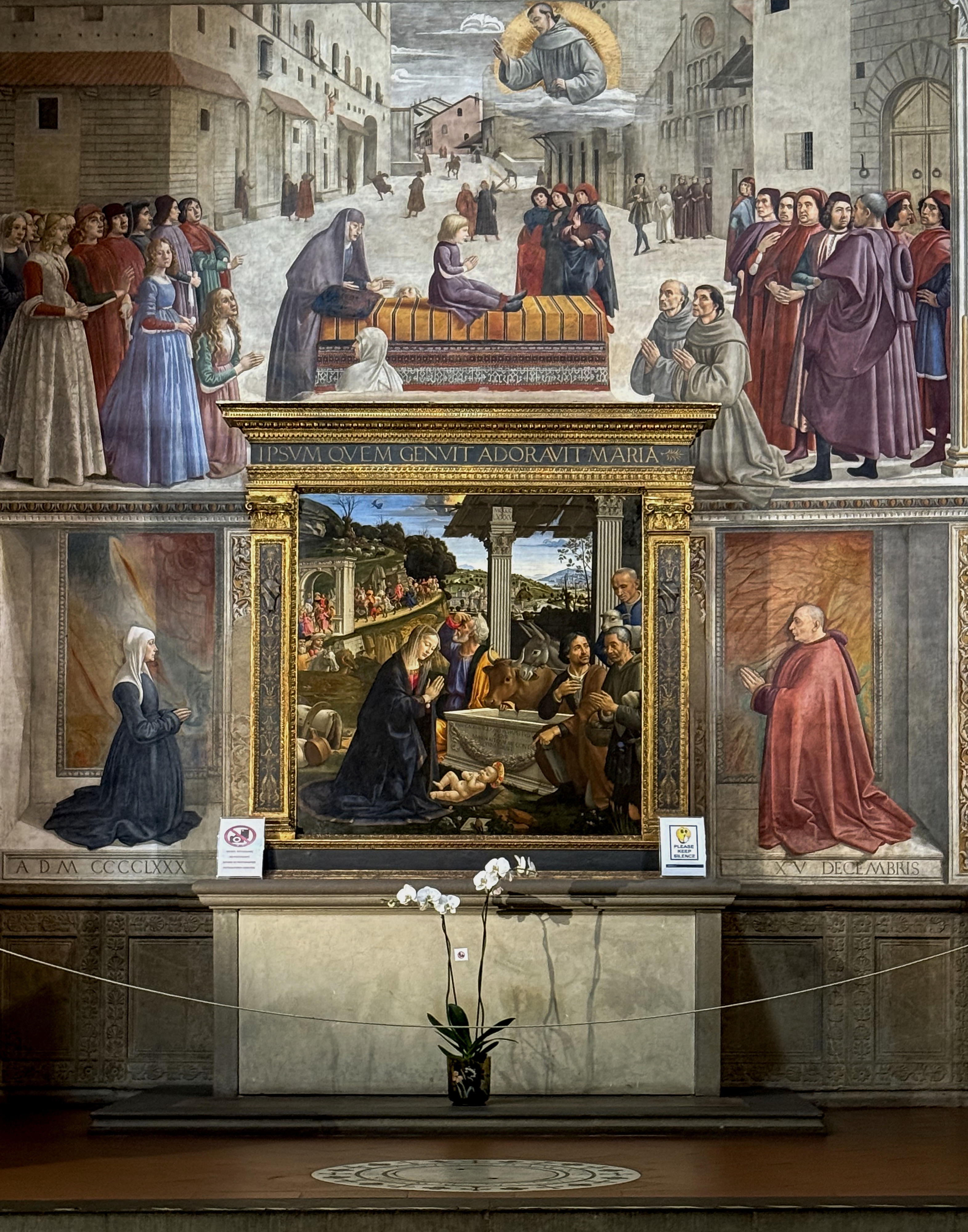
Domenico Ghirlandaio, Anbetung der Hirten und Stifterpaar. Die 1485 datierte Altartafel und die Realitätsnähe der Figuren bezeugen den unmittelbaren Einfluss des Portinari-Altars von Hugo van der Goes (1435/40-1482). Das riesige Triptychon aus den Niederlanden trifft 1483 in Florenz ein (heute in den Uffizien).
Domenico Ghirlandaio, Adoration of the Shepherds and the Donor Couple. The altarpiece, dated 1485, and the realism of the figures testify to the direct influence of the Portinari Altarpiece by Hugo van der Goes (1435/40-1482). The huge triptych from the Netherlands arrived in Florence in 1483 (today in the Uffizi).
Florenz – Cappella Sassetti: Nera und Francesco Sassetti
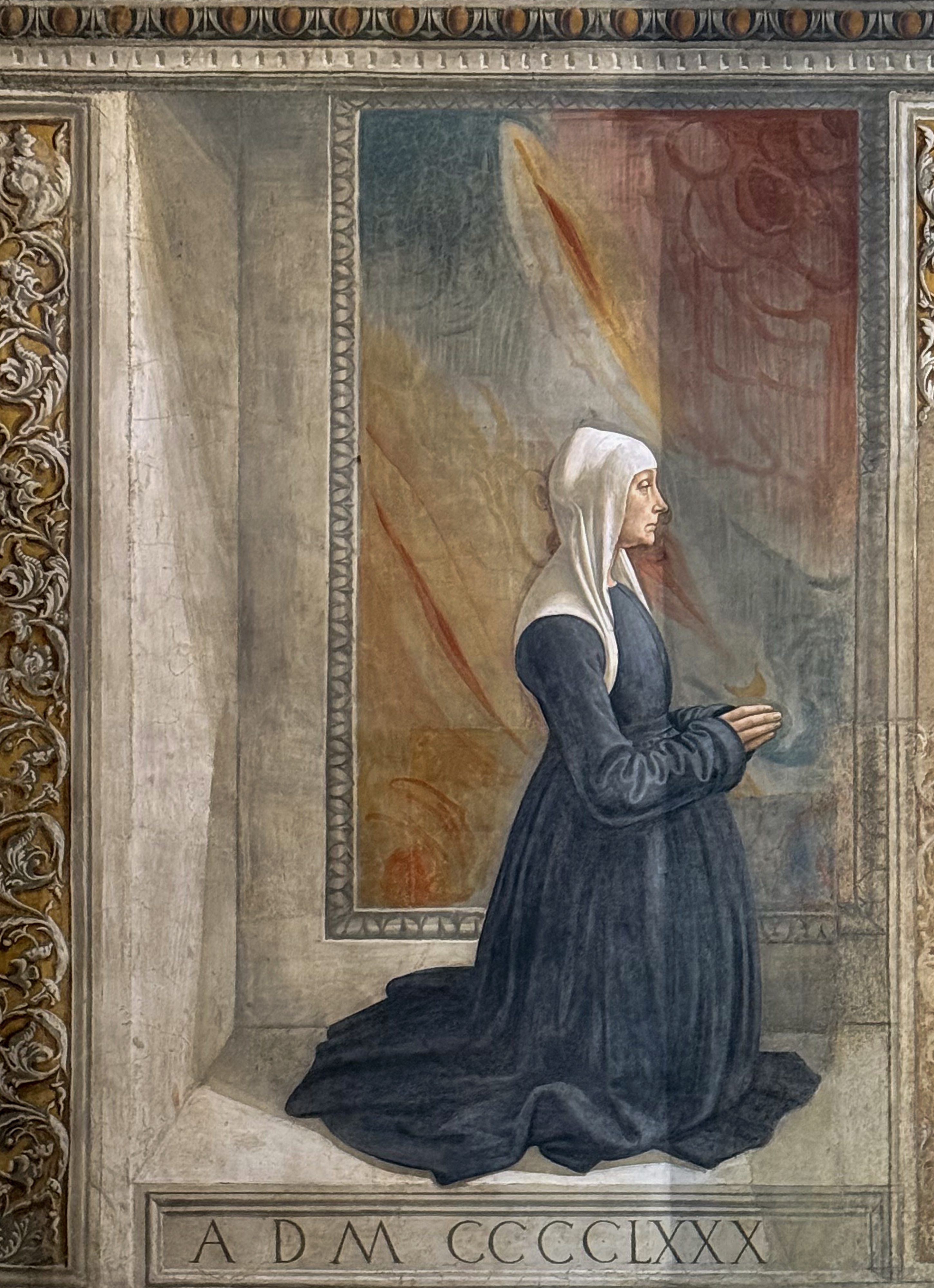
Florenz – Cappella Sassetti, Domenico Ghirlandaio, Nera Sassetti (1444-1507) aus der angesehenen Familie der Corsi kniet als etwa 40jährige Stifterin in einer gemalten Marmornische. Unter ihr und ihrem Mann ist das Datum des Vertragsabschlusses mit Ghirlandaio zu lesen. Sie ist an der linken Seitenwand in einem Grabmal bestattet, das Giuliano da San Gallo (um 1445-1516) gestaltet hat. Es ist das einzige für eine verheiratete Frau in Florenz im 15. Jh.
Nera Sassetti (1444-1507) from the prestigious Corsi family, aged around 40, kneels in a painted marble niche. Below her and her husband, the date on which the contract was signed can be read. She is buried on the left side wall in a tomb designed by Giuliano da San Gallo (around 1445-1516). It is the only one for a married woman in Florence in the 15th century.
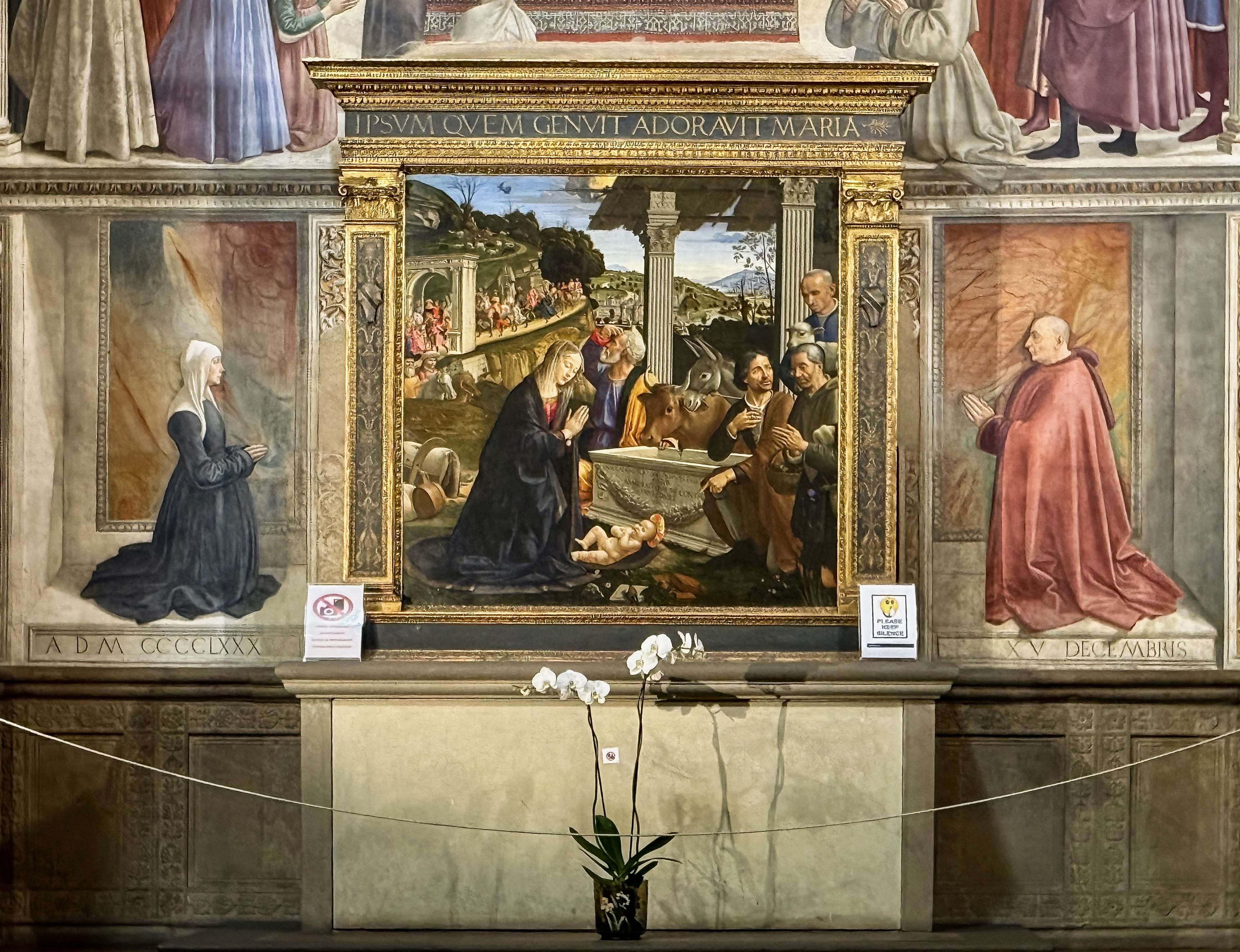
Aus der Ferne wirken die betenden Stifter in ihren gemalten Marmornischen fast wie Figuren eines Flügelalters. Sie übertreffen an Größe die Gestalten des Bildes. Dieses erhält dadurch auch ein wenig den Charakter einer Vision.
From a distance, the praying donors in their painted marble niches look almost like figures from a winged altarpiece. They are larger than the figures in the painting. This also gives the painting the character of a vision.
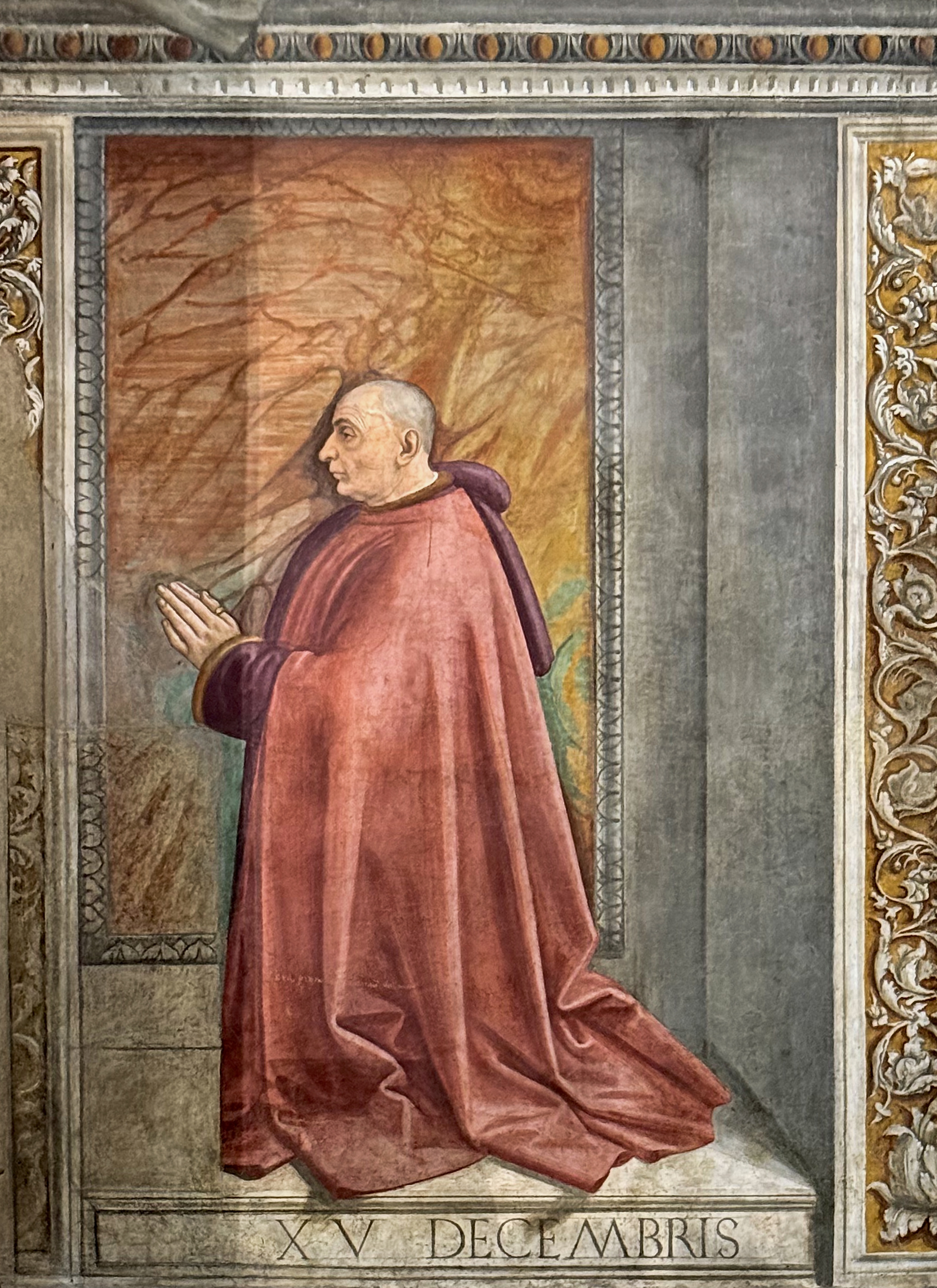
Fast zwei Jahrzehnte liegen zwischen der gezeigten Marmorbüste und diesem Bildnis. Sassetti ist für seine Zeit mit knapp 65 Jahren ein alter Mann. Ghirlandaio malt ihn wie seine Frau als würdevolle Einzelperson und feiert damit auch seine mäzenatische Leistung.
Almost two decades lie between the marble bust on display and this portrait. At just under 65, Sassetti is an old man for his time. Ghirlandaio paints him, like his wife, as a dignified individual
and thus also celebrates his patronage.
Einfluss von Hugo van der Goes‘ Portinari-Altar

Domenico Ghirlandaio, Anbetung der Hirten, linke Altarseite. Maria betet ihren göttlichen Sohn an, der auf ihrem Mantel vor einem antiken Sarkophag liegt. Joseph blickt hinauf zu einer felsigen Höhe, über der ein Engel den Hirten erscheint. Darunter zieht das Gefolge der Hl. Drei Könige durch ein Triumphtor. Die ferne, detailreiche Landschaft verrät Ghirlandaios Bewunderung des Portinari-Altars.
Ghirlandaio, Adoration of the Shepherds, left side of the altar. Mary is worshipping her divine son, who is lying on her mantle in front of an ancient sarcophagus. Joseph looks up to a rocky height above which an angel appears to the shepherds. Below, the entourage of the Magi passes through a triumphal gate. The distant, detailed landscape reveals Ghirlandaio’s admiration for the Portinari Altarpiece.

Rechte Altarhälfte: noch mehr als in der Landschaft zeigt sich die Auseinandersetzung mit dem Meisterwerk von Hugo van der Goes in der Darstellung der Hirten. Das sind nicht mehr idealisierte Gestalten biblischer Vergangenheit, sondern Zeitgenossen, deren Gesichter und Hände von Individualität und Arbeit zeugen.
Right half of the altar: even more so than in the landscape, the depiction of the shepherds shows the artist’s engagement with Hugo van der Goes‘ masterpiece. These are no longer idealized figures from the biblical past, but contemporaries whose faces and hands bear witness to individuality and work.
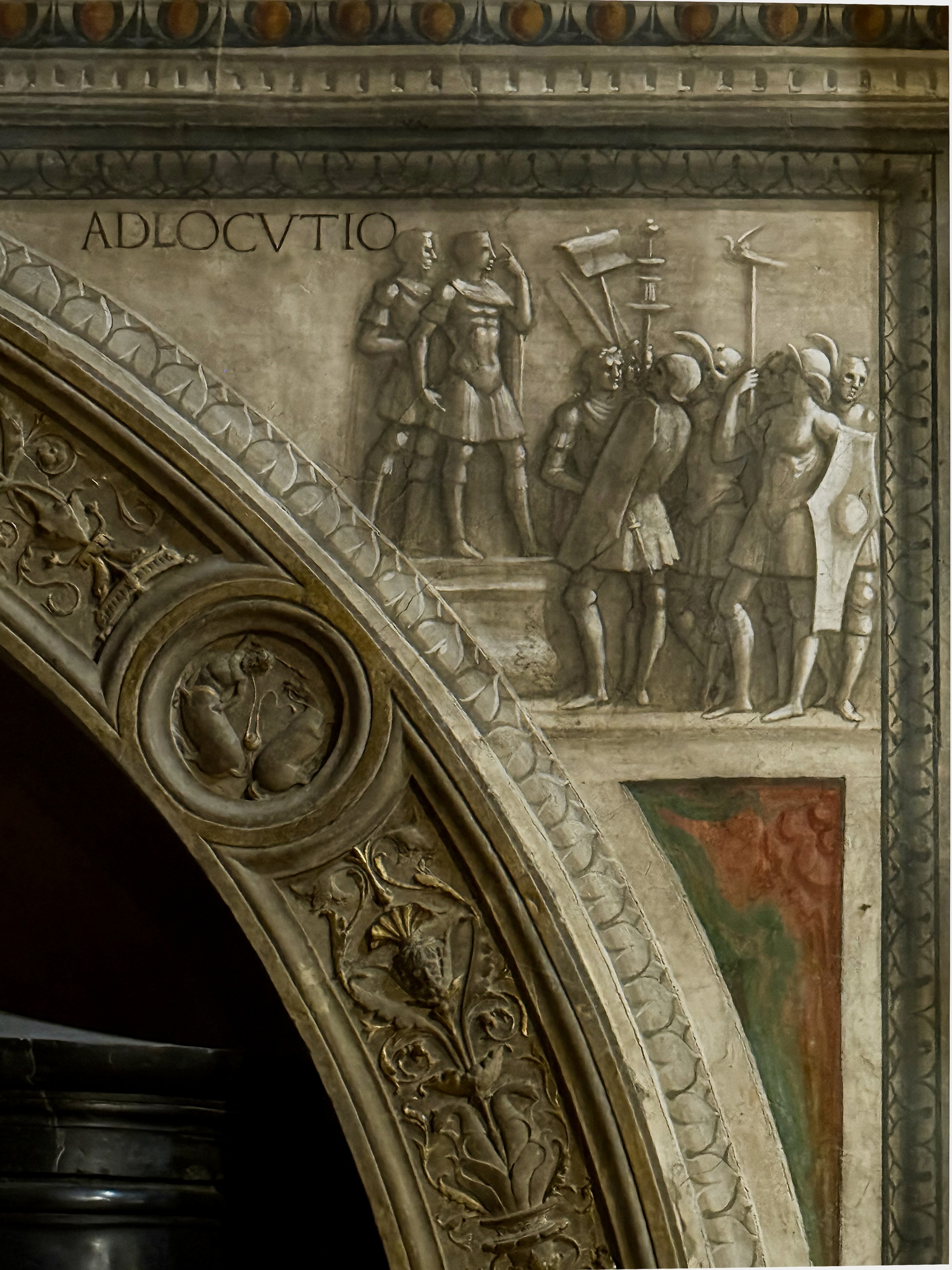
Ein Detail mit einer Adlocutio, einer Ansprache an römisches Militär, oberhalb der Nische mit dem Sarkophag von Francesco Sassetti.
A detail with an adlocutio, an address to the Roman military, above the niche with the sarcophagus of Francesco Sassetti.
Das Stifterpaar in Nahsicht

Domenico Ghirlandaio, Stifterin Nera Corsi, verheiratet mit Francesco Sassetti
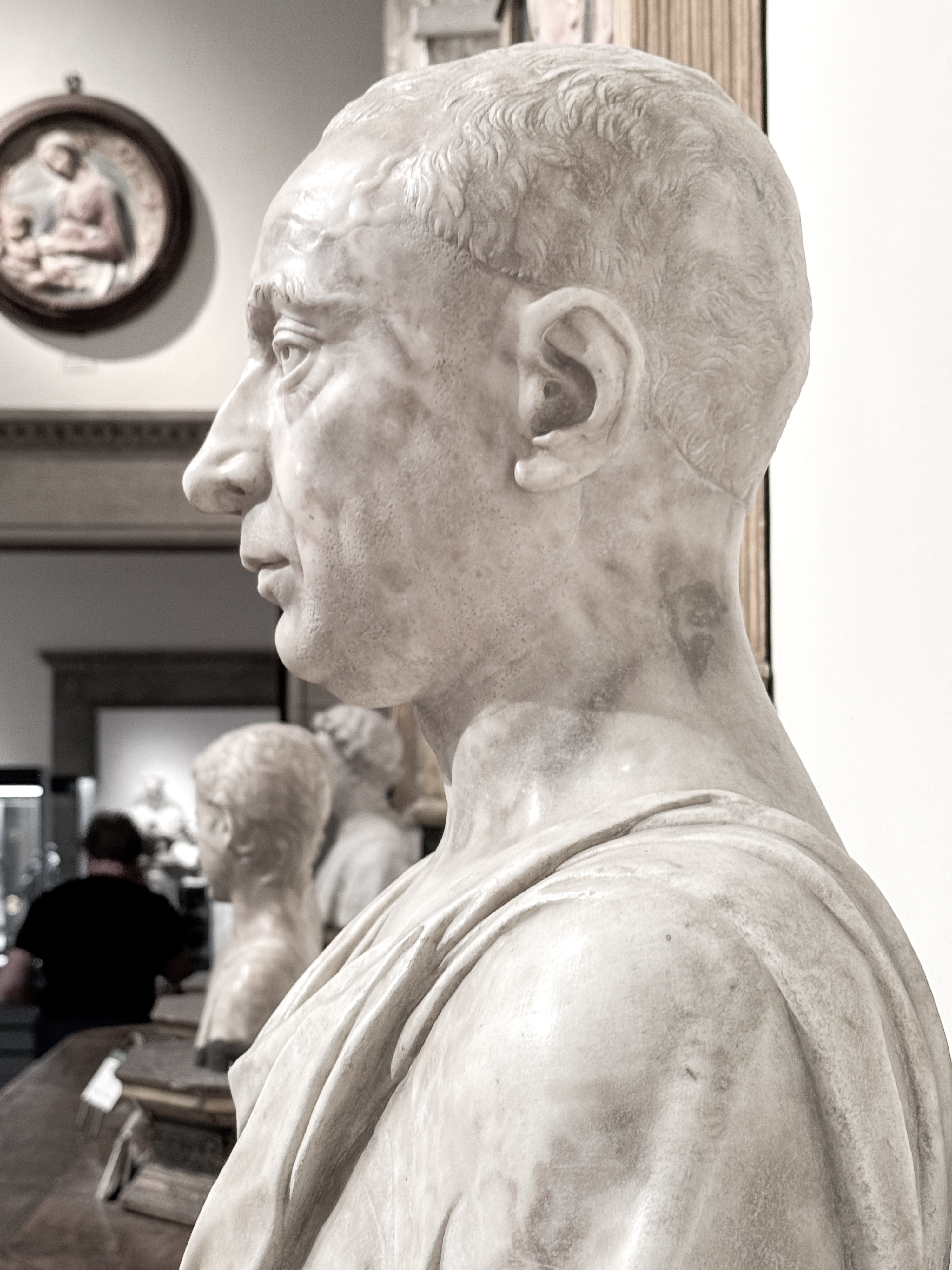
Marmorbüste Francesco Sassetti, s. oben. Der als Bankier und auch sonst einflussreiche Florentiner mit energischem Gesichtsausdruck in seinen frühen Vierzigern
Marble bust of Francesco Sassetti, see above. The Florentine, influential as a banker and otherwise, with an energetic facial expression in his early forties.
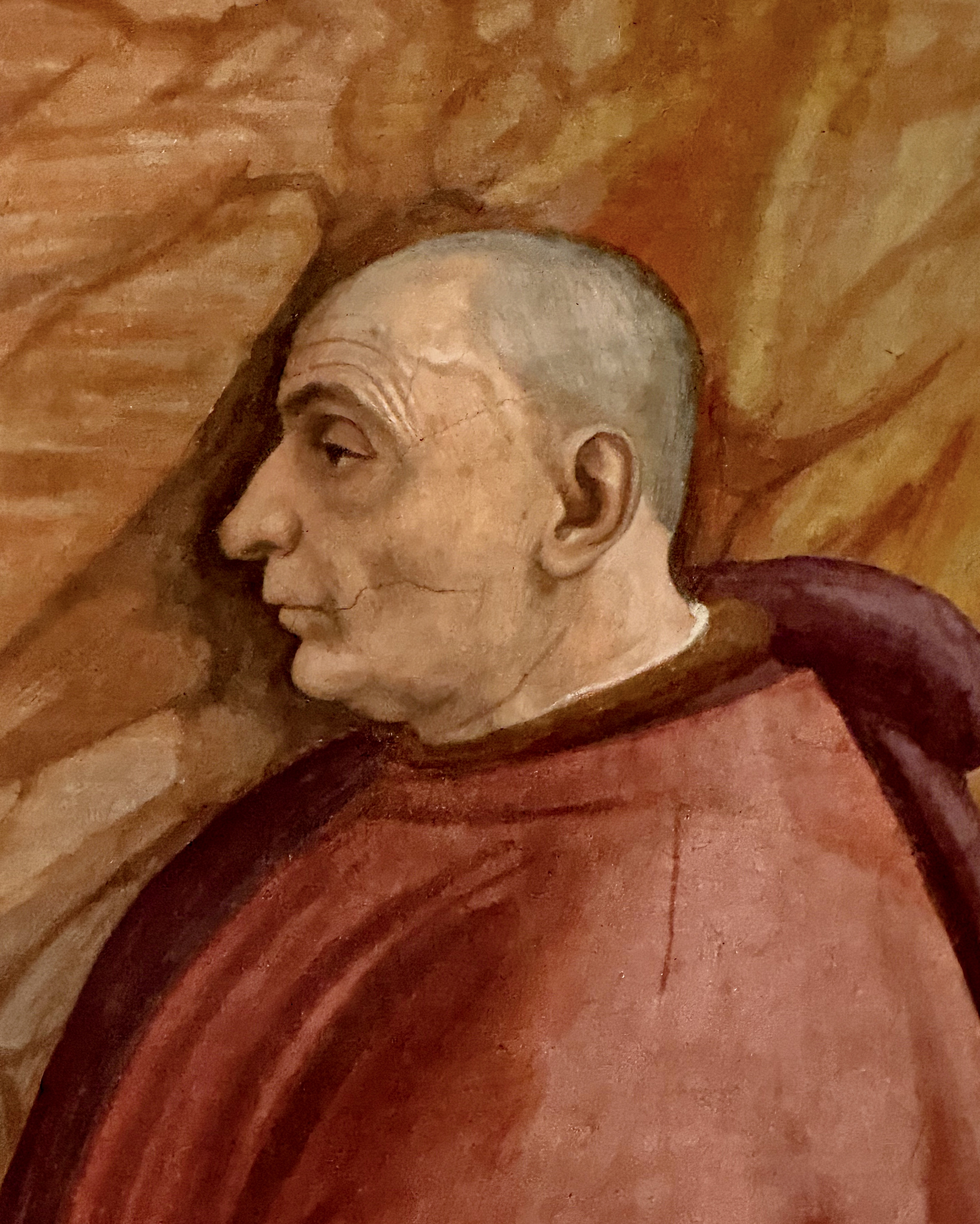
Domenico Ghirlandaio, Francesco Sassetti, eine Schlüsselfigur im Umfeld der Medici. Eines der vielen Meisterbildnisse des florentinischen Quattrocento.
Domenico Ghirlandaio, Francesco Sassetti, an important figure in the Medici circle. One of the many master portraits of the Florentine Quattrocento.
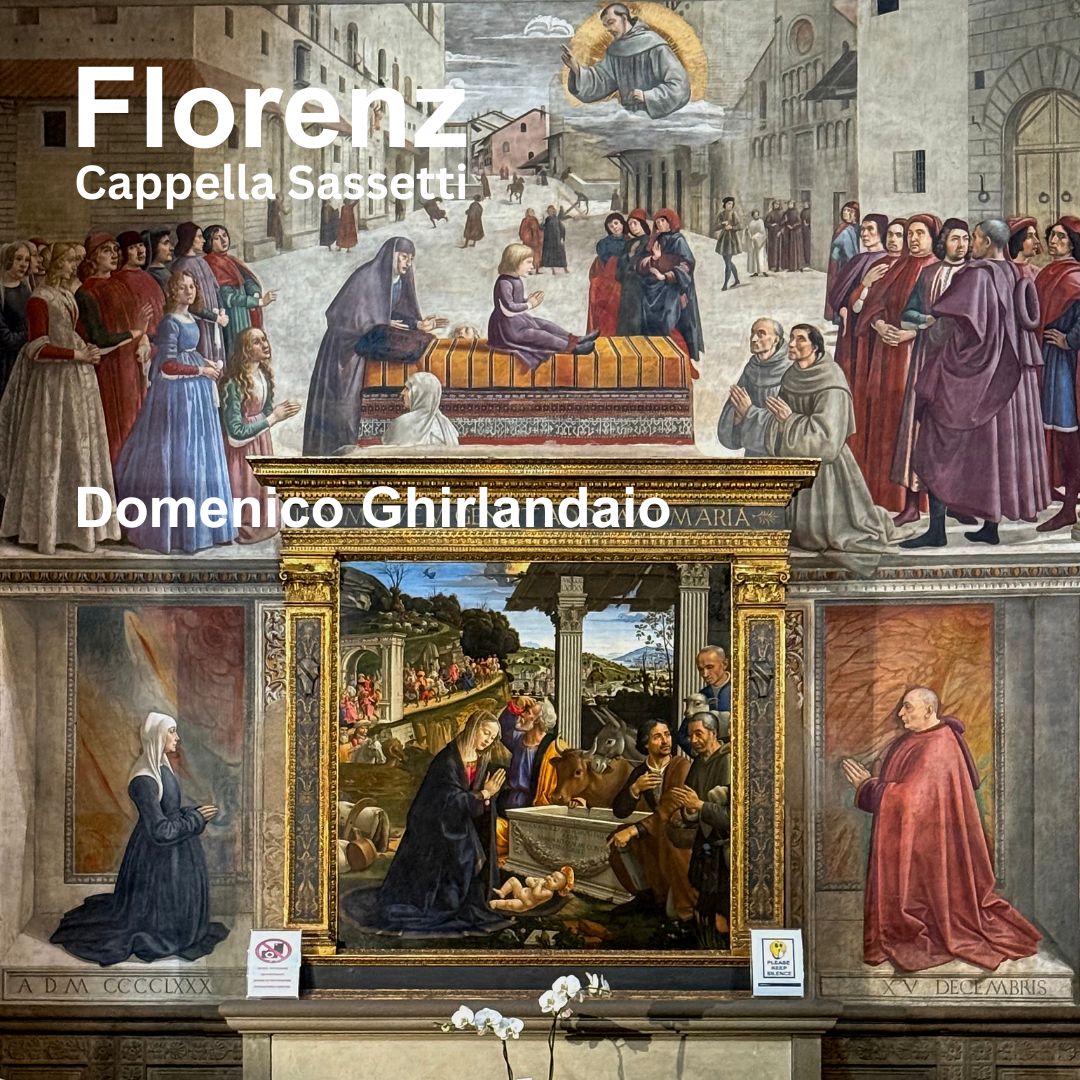
Danke lieber Christian für den Besuch bei Francesco Sassetti mit Hilfe von Domenico Ghirlandaio. Was für schöne Bilder!
Herzlich dankend
Willi